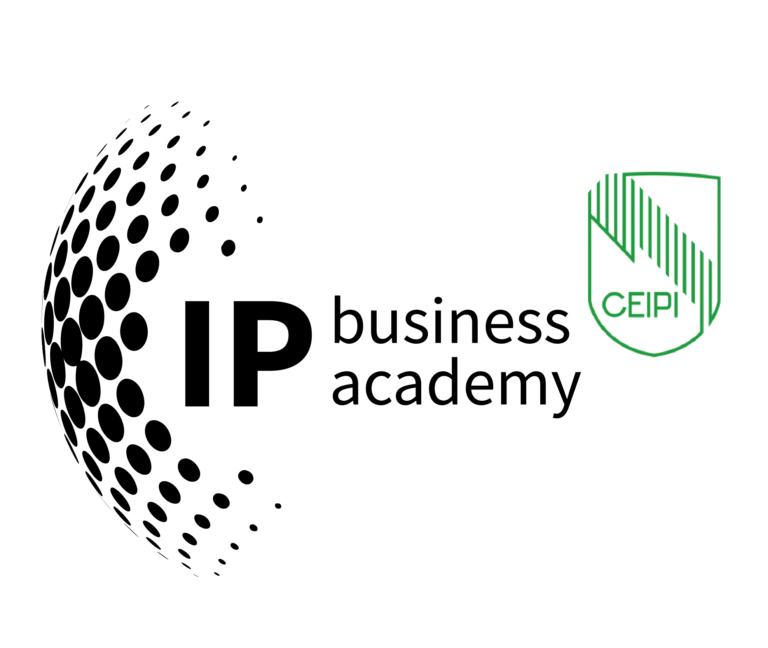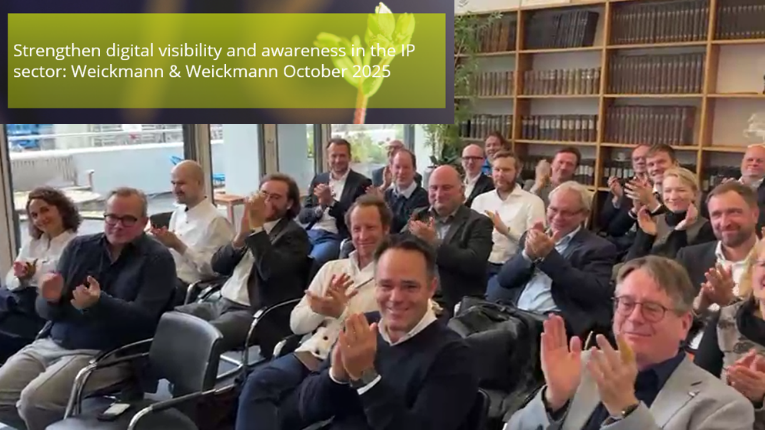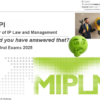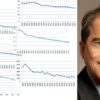Strengthening Digital Visibility in IP: Highlights from the Weickmann & Weickmann Expert Exchange
On Friday, 10 October 2025, Weickmann & Weickmann hosted an all-day exchange in Munich focused on one question that increasingly shapes success in our field: how can IP professionals build digital visibility and genuine awareness without sacrificing substance and integrity? From morning keynotes to an afternoon roundtable and World-Café, the day connected practical methods with strategic context — and, importantly, with a community that wants to learn openly from one another.
Summary of the event results
Why visibility has become a strategic topic
The opening framed the day with a simple reality: expertise alone no longer ensures that clients find, understand, and trust you. Digital presence — consistent, credible, and useful — now functions as a strategic asset in its own right. The agenda set that tone clearly, positioning the event as a practitioner-led exchange rather than a showcase, and situating the conversation at Weickmann & Weickmann’s Munich offices from 10:00 to 16:00.
From invisible expert to visible authority — Giulia Donato
Brand and communications advisor Giulia Donato opened with “Personal Branding in the IP Sector: how to become visible and relevant as an expert.” Her premise: personal branding is not vanity; it is the disciplined, strategic visibility of your expertise. Giulia articulated four business levers — accelerated trust-building, differentiation in crowded markets, broader influence, and alignment between perceived and delivered value — that translate visibility into measurable impact.
She challenged familiar objections. Is personal branding “self-promotion”? Not if we design it around signals that help stakeholders evaluate quality. What about confidentiality? Share patterns, anonymized insights, and thought leadership rather than case specifics. And time? Thirty to sixty minutes a week, invested consistently, compounds. The talk backed these points with data illustrating how visible leaders influence B2B decisions, out-perform corporate pages in impressions, and convert networks into qualified conversations — evidence that consistency, not volume, changes outcomes.
Equally valuable was Giulia’s concrete path forward: define a clear positioning (what you want to be known for in two years), craft a professional story anchored in values and “the why,” select platforms deliberately (with LinkedIn as the base), and favor constancy over intensity — one intentional contribution per week beats sporadic bursts. Her actionable first-month checklist (from identifying top-three expertise areas to publishing one article and having five purposeful industry conversations) gave participants a pragmatic starting line.
What actually works in practice — Maria Boicova-Wynants
Maria Boicova-Wynants brought the practitioner’s lens: which formats work in the IP world and how to remain authentic while using them. She emphasized a portfolio approach — short LinkedIn insights, longer articles and interviews, and participation in focused webinars — coordinated around a coherent theme rather than scattered activity. The honesty of her perspective stood out: success comes from clarity and patience, not flamboyant campaigns; credibility grows when experts consistently make complex topics understandable. A recording of Maria’s talk is available online.
LinkedIn strategies & the IP Subject Matter Expert Program — Prof. Alexander J. Wurzer
The next session examined how LinkedIn has evolved into a working arena for IP experts. The message: audiences recognize and reward clarity of theme, accessible language, and steady contribution across neutral platforms. To help experts operationalize this, several tools from the 🌱 Resource Hub were presented: LinkedIn Essentials: Boost Your Profile (profile as a business instrument, not a résumé), Referral Marketing for IP Experts (turning trust into long-term relationships), and the LinkedIn About Tuner (crafting an authentic, well-structured “About” section). Each is designed to support positioning and credibility without resorting to empty slogans.
Prof. Wurzer also outlined the IP Subject Matter Expert Program: a framework for experts to connect deep, often technical competence with visible contributions across the IP Business Academy ecosystem — articles, interviews, letters, and discussions — while engaging with decision-makers in innovation contexts. Real examples (e.g., themed content ladders over several months and cross-format storytelling) illustrated how expertise can be organized into sequences that build authority and open qualified conversations.
Channels, formats, and communities — Dr. Tobias Denk
If personal branding and expert positioning set the “why,” Dr. Tobias Denk mapped the “how.” He contrasted firm brands and personal brands—both valuable, but with different strengths — and explained why “people follow people” on social networks. Visibility scales when we orchestrate channels that serve different functions: news channels to highlight what’s relevant now; deep-dive channels to analyze meaning and implications; learning channels to build capability through guides and checklists; and community channels (live interviews, conferences, discussions) to ensure dialogue rather than one-way broadcasting.
Crucially, these channels must support the client journey — awareness, consideration, conversion, and engagement — without becoming mechanical. Dr. Denk emphasized that recognition grows when individuals coordinate content across neutral, trusted platforms and when communities validate and transmit expertise. The Ambassador Program illustrated how networks of credible practitioners amplify one another’s work across geographies and topics.
Looking ahead — the Open Foresight Board with Theo Grünewald
In the early afternoon, Theo Grünewald introduced the Open Foresight Board, a collaborative mechanism that links personal and expert branding to the strategic horizon of IP management. Members — senior practitioners from industry IP functions — help identify and prioritize emerging trends, contribute to the IP Trend Radar, and align outputs with recognized standards such as ISO 56006 and DIN 77006. The Board is embedded in IPBA Connect, a multi-channel platform (news, blog, newsletter, letters, glossary, podcast, LinkedIn Live, and the dIPlex digital lexicon) that integrates contributions, curates quality, and connects experts with users of the IP system.
By situating visibility within a foresight process, the session showed how experts can participate in shaping debates before they crystallize into business as usual — turning communication into a form of shared sense-making for the IP community.
Roundtable: what works, what doesn’t
The open roundtable “Digital Visibility in Practice,” moderated in partnership with the host team, distilled field lessons: visibility must be useful; consistency beats intensity; and credibility grows when knowledge aligns with user needs, not when we speak only to peers. Participants compared approaches across sectors and roles, testing how different formats perform for distinct audiences and how to maintain tone and ethics while being more present online. The agenda intentionally created this space for candid exchange after the structured morning.
World-Café: from insights to action
The World-Café turned the themes into commitments. Giulia’s prompts catalyzed the discussion: if we protect clients’ brands daily, how systematically do we manage our own? Does visibility threaten seriousness, or has it become part of it? Where is the line between professional presence and self-display? And what would change if we treated our positioning with the same discipline we apply to a case? These questions helped participants articulate first steps, from clarifying a niche to publishing a single, high-quality insight each week.
A community moment — over lunch and beyond
The networking lunch was not a pause; it was an extension of the program’s intent. Many conversations explored practical roadblocks — time, tone, and fear of imperfection — and shared techniques to keep momentum (small weekly habits, repurposing insights across formats, pairing up with a colleague for mutual accountability). The day closed with a summary and next steps: keep the exchange going, test ideas in public, and align activity across channels so visibility compounds rather than fragments.
Participant statements:
Martin Bookjans
“The power of AI is again and again overwhelming, here in particular in the context of selfmarketing-focused content generation in general and LinkedIn in particular. Thank you very much for the precious insights! It would be great if this platform became a regular thing.”
Andreas Jacob
“The practical tips on realistically integrating visibility into everyday legal work were very valuable. It became clear that even small, consistent steps can have a noticeable effect. The examples clearly illustrated how IP professionals can build their presence without losing focus on the substance of their work.”
Axel Oldekop
“It’s becoming increasingly important for law firms not only to demonstrate expertise but also to explain it. The discussions showed how digital communication can support credibility and differentiation at the same time. It was a good reminder that expertise becomes most valuable when it is also visible and understood.”
What this day tells us about the future of visible expertise in IP
Three conclusions stand out.
First, visibility is a quality practice. When experts communicate clearly and consistently, they lower search and evaluation costs for clients and partners. The result is not noise; it is better matching between needs and capabilities. Giulia’s framework showed how trust, differentiation, influence, and value alignment emerge from disciplined communication, not from theatrics.
Second, systems beat sporadic effort. Orchestrated channels and formats, as outlined by Dr. Denk, prevent the common pattern of isolated posts that do not accumulate recognition. When news, deep analysis, learning materials, and live dialogues connect to one another and to a coherent expert profile, they create a self-reinforcing cycle of attention and understanding.
Third, foresight anchors relevance. The Open Foresight Board links today’s visibility with tomorrow’s topics, ensuring that contributions anticipate shifts rather than merely reacting to them. In this sense, visibility becomes stewardship: experts help the community see what is coming and prepare responsibly.
The Weickmann & Weickmann exchange embodied a tone the IP community needs: practical, collaborative, and respectful of the time pressures that make visibility hard. It offered frameworks, tools, and examples — from profile essentials to structured content ladders and platform programs for Subject Matter Experts — that participants can adapt immediately.
Most of all, it confirmed that making expertise visible is not a departure from professional standards; it is a way to uphold them in a digital environment. When knowledge is findable and understandable, it becomes useful — and usefulness is the foundation of trust. That is how reputations are built, how good work is recognized, and how our field continues to innovate with confidence.



